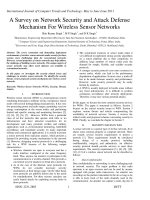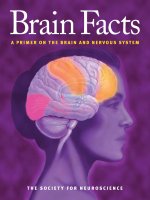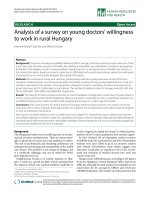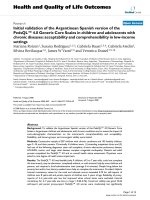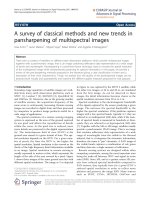Industry 4.0: A Survey on Technologies, Applications and Open Research Issues
Bạn đang xem bản rút gọn của tài liệu. Xem và tải ngay bản đầy đủ của tài liệu tại đây (2.41 MB, 41 trang )
Accepted Manuscript
Industry 4.0: A Survey on Technologies, Applications and Open
Research Issues
Yang Lu
PII:
DOI:
Reference:
S2452-414X(17)30004-3
10.1016/j.jii.2017.04.005
JII 36
To appear in:
Journal of Industrial Information Integration
Received date:
Revised date:
Accepted date:
25 January 2017
14 April 2017
15 April 2017
Please cite this article as: Yang Lu , Industry 4.0: A Survey on Technologies, Applications and Open
Research Issues, Journal of Industrial Information Integration (2017), doi: 10.1016/j.jii.2017.04.005
This is a PDF file of an unedited manuscript that has been accepted for publication. As a service
to our customers we are providing this early version of the manuscript. The manuscript will undergo
copyediting, typesetting, and review of the resulting proof before it is published in its final form. Please
note that during the production process errors may be discovered which could affect the content, and
all legal disclaimers that apply to the journal pertain.
ACCEPTED MANUSCRIPT
1
Title Page
CR
IP
T
Industry 4.0
Industry 4.0: A Survey on Technologies, Applications and Open Research Issues
Yang Lu
AN
US
University of Kentucky
Lexington, Kentucky 40506
USA
University of Manchester
Manchester M13 9PL
UK
ED
M
{}
Abstract
PT
Originally initiated in Germany, Industry 4.0, the fourth industrial revolution, has attracted much
attention in recent literatures. It is closely related with the Internet of Things (IoT), Cyber Physical
CE
System (CPS), information and communications technology (ICT), Enterprise Architecture (EA), and
Enterprise Integration (EI). Despite of the dynamic nature of the research on Industry 4.0, however, a
AC
systematic and extensive review of recent research on it is has been unavailable. Accordingly, this paper
conducts a comprehensive review on Industry 4.0 and presents an overview of the content, scope, and
findings of Industry 4.0 by examining the existing literatures in all of the databases within the Web of
Science. Altogether, 88 papers related to Industry 4.0 are grouped into five research categories and
reviewed. In addition, this paper outlines the critical issue of the interoperability of Industry 4.0, and
ACCEPTED MANUSCRIPT
Industry 4.0
2
proposes a conceptual framework of interoperability regarding Industry 4.0. Challenges and trends for
future research on Industry 4.0 are discussed.
Key Words:
Industry 4.0, Cyber Physical System, Internet of Things, Big Data, Enterprise Architecture, Enterprise
AC
CE
PT
ED
M
AN
US
CR
IP
T
Integration
ACCEPTED MANUSCRIPT
Industry 4.0
3
I. Introduction
Modern industry industrial development has lasted for several hundred years and has now
the era of Industry 4.0 comes. The concept of Industry 4.0 was initially proposed for developing
CR
IP
T
German economy in 2011 (Roblek, Meško & Krapež, 2016; Vogel-Heuser & Hess, 2016).
According to Lukac (2015), the first industrial revolution begins began at the end of the 18th
century and is was represented by mechanical production plants based on water and steam power;
the second industrial revolution starts started at the beginning of the 20th century with the
AN
US
symbol of mass labor production based on electrical energy; the third industrial revolution
begins began in the 1970s with the characteristic of automatic production based on electronics
and internet technology; and right now, the fourth industrial revolution, namely Industry 4.0, is
ongoing, with the characteristics of cyber physical systems (CPS) production, based on
M
heterogeneous data and knowledge integration. The main roles of CPS is are to fulfill the agile
ED
and dynamic requirements of production, and to improve the effectiveness and efficiency of the
entire industry. Industry 4.0 encompasses numerous technologies and associated paradigms,
PT
including Radio Frequency Identification (RFID), Enterprise Resource Planning (ERP), Internet
of Things (IoT), cloud-based manufacturing, and social product development (Baur & Wee,
CE
2015; Georgakopoulos, et et al., 2016; Kube & Rinn, 2014; Lasi, et et al, 2014; Lin, et et al.,
AC
2016; Lom, Pribyl & Svitek, 2016; Pfeiffer, 2016; Roblek, Meško & Krapež, 2016; Singer, 2016;
Thames & Schaefer, 2016; Thamsen & Wulff, 2016; Vijaykumar, Saravanakumar &
Balamurugan, 2015; Wan, et et al., 2016).
The goals of Industry 4.0 is are to achieve a higher level of operational efficiency and
productivity, as well as a higher level of automatization (Thames & Schaefer, 2016). As Roblek,
Meško & Krapež (2016) and Posada, et et al. (2015) point out, the five major features of Industry
ACCEPTED MANUSCRIPT
Industry 4.0
4
4.0 are digitization, optimization, and customization of production; automation and adaptation;
human machine interaction (HMI); value-added services and businesses, and automatic data
exchange and communication. These features not only are highly correlated with internet
process of value adding and knowledge management.
CR
IP
T
technologies and advanced algorithms, but they also indicate that Industry 4.0 is an industrial
Despite of the dynamic nature of the research on Industry 4.0, however, a systematic and
extensive review of recent research on Industry 4.0 is not available. Accordingly, this paper
conducts a comprehensive review on of Industry 4.0 and presents an overview of the content,
AN
US
scope, and findings of Industry 4.0 by examining existing literatures in all databases within the
Web of Science and Google Scholar. Altogether, 88 papers related to Industry 4.0 are grouped
into five research categories and are reviewed. In addition, this paper outlines the critical issue of
M
the interoperability of Industry 4.0, and proposes a conceptual framework of interoperability
regarding Industry 4.0. Challenges and trends for future research on Industry 4.0 are discussed.
ED
The rest of the paper is structured as follows: the methodology of this study is introduced
in Section 2. Section 3 groups the selected paper into five categories and reviews them in details.
PT
Challenges and directions for future research are introduced in each category. A framework of
II. Methodology
AC
paper.
CE
interoperability for Industry 4.0 is proposed as well. Section 4 summarizes and concludes this
This study follows the two-state approach initiated by Webster and Watson (2002) to
conduct a literature review. This approach has the capability of locating rigorous and relevant
research, and then guaranteeing the quality and veracity of the articles finally selected (Tranfield,
Denyer & Smart, 2003). The process of this approach is shown in Figure 1.
ACCEPTED MANUSCRIPT
5
M
AN
US
CR
IP
T
Industry 4.0
At the first stage, “Industry 4.0” was chosen as the keyword to search published papers
ED
from 2011 to 2016 collected by Web of Science and Google Scholar. The search returned103
PT
results, which indicates that Industry 4.0 is an emerging research topic. Next, citations of these
103 papers were extracted from Google Scholar. At the second stage, these 103 papers were
CE
carefully reviewed and unrelated papers were dropped. At the end, 88 papers were left. The
AC
distribution of publication years of these papers and their citation numbers are shown in Figure 2.
ACCEPTED MANUSCRIPT
Industry 4.0
6
Number of articles
Times cited
500
35
33
461
450
29
30
400
25
350
250
200
11
150
CR
IP
T
326
300
144
50
1
AN
US
100
1
3
5
0
1
2011
2
3
4
20
15
10
5
0
5
M
Figure 2. The distribution of publication years and ciatations (2011-2016)
From 2011 to 2016, the annual average number of published papers on Industry 4.0 was
ED
13 and the average annual citation is 157. The annual number of published papers increased
from one in 2011 to 33 in 2016. A quick increase occurred in 2014 from one in 2013 to 11.
PT
Annual citation of these papers reached a peak in 2014, with the number of 461. The changes in
CE
the number of published papers and citations indicate that Industry 4.0 began to attract attention
in literature from 2014. The 88 papers are then grouped into five research categories, as shown in
AC
Table 1.
Table 1. Research Categories of the selected 88 publications
Research categories
Number of publications
Concept and perspectives of Industry 4.0
18
CPS-based Industry 4.0
12
Interoperability of Industry 4.0
11
Key technologies of Industry 4.0
20
ACCEPTED MANUSCRIPT
Industry 4.0
7
Applications of Industry 4.0
27
Total: 88
The distribution of the categories indicates that more attention has been paid to
CR
IP
T
technologies / tools and applications regarding Industry 4.0 in recent literature. This indicates
that Industry 4.0 is not only an integration of CPS, ICT, Enterprise Architecture (EA), and IoT,
but that it is also an interoperability process.
III. Industry 4.0: The state of the art
AN
US
This section summarizes the content of selected 88 papers, which are grouped into five
research categories. Potential directions for future research are discussed in the research category,
as well.
1. Concept and perspectives of Industry 4.0
M
Scholars have defined Industry 4.0 from diverse perspectives in this research category.
ED
For instance, according to the Consortium II. Fact Sheet (2013), Industry 4.0 is “the integration
of complex physical machinery and devices with networked sensors and software, used to predict,
PT
control and plan for better business and societal outcomes.” Henning and Johannes (2013)
define Industry 4.0 as “a new level of value chain organization and management across the
CE
lifecycle of products.” Hermann, Pentek, and Otto (2016) define Industry 4.0 as “a collective
AC
term for technologies and concepts of value chain organization.” They note that, within the
modular structured Smart Factories of Industry 4.0, CPS monitor physical processes, create a
virtual copy of the physical world and make decentralized decisions. They point out that over the
IoT, CPS communicate and cooperate with each other and humans in real time, and that the
Internet of Services (IoS), both internal and cross organizational services, is offered and utilized
ACCEPTED MANUSCRIPT
Industry 4.0
8
by participants of the value chain. So far, there is no unanimously adopted definition of Industry
4.0.
Table 2. Publication in the research category of Concept and perspectives of Industry 4.0
Research category
Publications
Bagheri, et al. (2015)
CR
IP
T
Baur, C., & Wee, D. (2015)
Consortium II. (2013)
Drath, R., & Horch, A. (2014)
Henning Kagermann WW & Johannes Helbig
(2013)
AN
US
Hermann, M., Pentek, T., & Otto, B. (2016)
Kube, G., & Rinn, T. (2014)
Li, et al. (2015)
Lukač, D. (2015)
AC
CE
PT
ED
M
Concept and perspectives of Industry 4.0
Pfeiffer, S. (2016)
Pfeiffer, S., & Suphan, A. (2015)
Posada, et al. (2015)
Singer, Pete. (2016)
Staley, S. & Warfield, J. (2007)
Varghese, A., & Tandur, D. (2014)
Vogel-Heuser & Hess (2016)
Warfield, J. (2007)
Xu, L. (2011)
Zhou, K., Liu, T., & Zhou, L. (2015)
Industry 4.0 facilitates inter-connection and computerization into the traditional industry.
The goals of Industry 4.0 are to provide IT-enabled mass customization of manufactured
products; to make automatic and flexible adaptation of the production chain; to track parts and
ACCEPTED MANUSCRIPT
Industry 4.0
9
products; to facilitate communication among parts, products, and machines; to apply humanmachine interaction (HMI) paradigms; to achieve IoT-enabled production optimization in smart
factories; and to provide new types of services and business models of interaction in the value
chain (Shafiq et al., 2015 & 2016). Industry 4.0 brings disruptive changes to supply chains,
CR
IP
T
business models, and business processes (Schmidt et al., 2015). The principles of Industry 4.0
are interoperability, virtualization, decentralization, real-time capability, service orientation, and
modularity (Shafiq et al., 2015 & 2016). In terms of features, Industry 4.0 can provide more
flexibility, reduce lead times, customize with small batch sizes, and reduce costs (Shafiq et al.,
AN
US
2015 & 2016). The key fundamental principles of Industry 4.0 include cloud/intranet, data
integration, flexible adaptation, intelligent self-organizing, interoperability, manufacturing
process, optimization, secure communication, and service orientation (Ji et al., 2016; Vogel-
M
Heuser & Hess, 2016). Based on the papers in this research category, Industry 4.0 can be
summarized as an integrated, adapted, optimized, service-oriented, and interoperable
ED
manufacturing process which is correlate with algorithms, big data, and high technologies.
2. Cyber-Physical Systems (CPS) based Industry 4.0
PT
As an emerging technology, Cyber-Physical Systems (CPS) is expected to offer
CE
promising solutions to transform the operation and role of many existing industrial systems
(Bondar et al 2016; Gürdür et al 2016; Mao et al, 2016; Xu, 2016; Yan et al 2015; Zhai et al
AC
2016).This research category has thirteen papers, as shown in Table 3, which cover CPS. CPS
are industrial automation systems that integrate innovative functionalities through networking to
enable connection of the operations of the physical reality with computing and communication
infrastructures (Bagheri et al., 2015; Harrison, Vera & Ahmad, 2016; Jazdi, 2014; Lee, Bagheri
& Kao, 2015; Monostori et al., 2016; Mosterman & Zander, 2016; Shafiq et al., 2015).
ACCEPTED MANUSCRIPT
Industry 4.0
10
Shafiq et al. (2015) define CPS as “the convergence of the physical and digital
worlds by establishing global networks for business that incorporate their machinery,
warehousing systems and production facilities” (p. 1149). Monostori et al. (2016), on the other
hand, note that “CPS are systems of collaborating computational entities which are in intensive
CR
IP
T
connection with the surrounding physical world and its on-going processes, providing and using,
at the same time, data-accessing and data-processing services available on the Internet” (p. 621).
CPS consist of microcontrollers that control the sensors and actuators. Data and information are
exchanged among embedded computer terminals, wireless applications, houses, or even clouds.
AN
US
The complex, dynamic, and integrated CPS will collaborate planning, analysis, modeling, design,
implement, and maintenance in the manufacturing process (Lasi et al, 2014).
PT
ED
M
Table 3. Publication in the research category of Cyber-Physical Systems (CPS) based
Industry 4.0
Research category
Publications
Bagheri, et al. (2015)
Brettel, et al. (2014)
Harrison, Vera & Ahmad (2016)
Ivanov, et al. (2014)
Ivanov, Sokolov & Ivanova (2016)
AC
CE
Cyber-Physical Systems (CPS) based Industry Jazdi (2014)
4.0
Kobara (2016)
Lee, Bagheri & Kao (2015)
Mosterman & Zander (2016)
Pérez, et al. (2015)
Schuster, et al. (2015)
Shafiq, et al. (2015)
Because CPS combine information and materials, decentralization and autonomy play
ACCEPTED MANUSCRIPT
Industry 4.0
11
important roles in improving the overall industrial performance (Ivanov, Sokolov & Ivanova,
2016). CPS are capable of increasing productivity, fostering growth, modifying the workforce
performance, and producing higher-quality goods with lower costs via the collection and analysis
of malicious data (Rüßmann et al., 2015). Jazdi (2014) presents an application of CPS and
CR
IP
T
demonstrates its redefined aspects, work processes, and development methods. Ivanov et al.
(2014) argue that dynamic models are needed in CPS to coordinate activities in manufacturing
procedures and to achieve an optimization of production. Based on a structure dynamic control
collaborating CPS networks in Industry 4.0.
AN
US
(SDC) mechanism, they develop a service-oriented dynamic model for dynamic scheduling and
Shafiq et al. (2015) assert that the combined structure of Virtual Engineering Objects
(VEO), Virtual Engineering Process (VEP), and Virtual Engineering Factory (VEF) is a
M
specialized form of CPS. VEO is a procedure of knowledge transition and data mining in which
one can capture and reuse the experience of engineering artifacts and can further benefit
ED
decision-making in industrial design and manufacturing (Brettel et al., 2014; Kobara, 2016;
Schuster et al., 2015; Shafiq et al., 2015). VEO integrates IT systems at different hierarchical
PT
levels throughout a manufacturing process. Furthermore, it can assist CPS to be more flexible
CE
and reconfigurable in a manufacturing process. It is an effective and critical system that performs
knowledge management well and plays an important role in factory planning (Posada et al.,
AC
2015). VEP is a knowledge representation of manufacturing process with all operation- required
information available, whereas VEF is an experience-based knowledge representation of an
engineering factory (Shafiq et al., 2015). Shafiq et al. (2015) argue that the integrated mechanism
of the three components is needed to build the structure of Industry 4.0 and to achieve a higher
level of intelligent machines and advanced analytics.
ACCEPTED MANUSCRIPT
Industry 4.0
12
Regarding the future of CPS, the challenges for scholars and practitioners are how to
implement CPS and how to improve CPS to become more reliable, stable, and capable are. Xu,
He, and Li (2014) point out that with the advances in wireless communication, smartphonse, and
sensor network technologies, CPS will make a large impact on new ICT and enterprise systems
CR
IP
T
technologies. Jazdi (2014) points out that distributed remote applications based on software
agents are the direction for future research on CPS. Monostori et al. (2016) note that both CPS
and the cyber physical production systems (CPPS) of Industry 4.0 will be activated and enforced
by the development of computational entities, data-related procedures, manufacturing
AN
US
automation and technology, and information and communication technologies (ICT). They
further point out that CPPS will dominate manufacturing systems by integrating with CPS as a
new generation of industry. CPPS involves humans, machines, and product, and combines
M
computation, networking, and physical processes together in the production process in order to
make the production more cost- and time-efficient with highly qualified products (Albers et al.,
ED
2016; Lasi et al, 2014). The embedded computers and networks in CPPS serve as headquarters to
monitor and to control the physical processes, feedback loops, and performance evaluations in
PT
the production process. Pérez et al. (2015) propose a framework for CPPS which consists of the
CE
Production Process Model (PPM), the Information Exchange Model (IEM), and the Plant
Information Model (PIM). Roblek, Meško & Krapež (2016) present an application of CPPS in
AC
which healthcare providers track patients via mobile applications, sensors in clothing, and
surveillance cameras in apartments for providing timely services.
In addition, another research direction is to develop a network of VEO, which has a wide
applicability of engineering artifacts integrating dual-computerized and real-world representation
ranging from simple stand-alone artifacts to complex multitasking machines (Brettel et al., 2014;
ACCEPTED MANUSCRIPT
Industry 4.0
13
Posada et al., 2015; Shafiq et al., 2015). Information exchanging with autonomy and with
intelligence is triggered by the real and the virtual productions. A VEO is able to add, store,
improve, and share knowledge through manufacturing system (Shafiq et al., 2015).
3. Interoperability of Industry 4.0
CR
IP
T
Industry 4.0 has two key factors: integration and interoperability (Chen et al., 2008; Lu,
2016; Romero & Vernadat, 2016). Integrated with malicious applications and software systems,
Industry 4.0 will achieve seamless operations across organizational boundaries and will realize
networked organizations (Ruggaber, 2006). Interoperability is one of the major advantages of
AN
US
Industry 4.0. According to Chen et al. (2008), interoperability is “the ability of two systems to
understand each other and to use functionality of one another.” It represents the capability of two
systems exchanging data and sharing information and knowledge (Synergy, 2005). The
M
interoperability of Industry 4.0 will synthesize software components, application solutions,
business processes, and the business context throughout the diversified, heterogeneous, and
ED
autonomous procedure (Berre et al., 2007).
The architecture of the Interoperability of Industry 4.0 includes four levels: operational
PT
(organizational), systematical (applicable), technical, and semantic interoperability (Berre et al.,
CE
2007; Gorkhail, A. & Xu, L., 2016; IEEE, 1990; Ruggaber, 2006; Sowell, 2006; Synergy, 2005).
Specifically, the operational interoperability illustrates general structures of concepts, standards,
AC
languages, and relationships within CPS and Industry 4.0. The systematical interoperability
identifies the guidelines and principles of methodologies, standards, domains, and models. The
technical interoperability articulates tools and platforms for technical development, IT systems,
ICT environment, and related software. The semantic interoperability ensures information
exchange among different groups of people, malicious packages of applications, and various
ACCEPTED MANUSCRIPT
Industry 4.0
14
levels of institutions. These four levels of operation make Industry 4.0 and CPS more productive
and cost-saving. Figure 3 shows the framework of interoperability of Industry 4.0.
Industry 4.0
Integrated
Integrated
Smart Factory
&
Manufacturing
Smart
Smart
City
Level of Interoperability
Product
Principles:
A. Operational
Accessibility
(Organizational)
Smart
CPS & CPPS
Grid
Security
Smart
Building
open source software
Multilateral solutions
Smart
Smart
Transportation
B. Systematical
AN
US
Multilingualism
CR
IP
T
Date
Things
Smart
(Applicable)
C. Technical
D. Semantic
Home
Facility
People
ED
Services
Integrated
M
Integrated
Figure 3. The Framework of Interoperability of Industry 4.0
PT
Literature has shown that Industry 4.0 has three frameworks, namely Command,
CE
Control, Communications, Computers, Intelligence, Surveillance and Reconnaissance (C4ISR);
Interoperable Delivery of European eGovernment Services to public Administrations, Business
AC
and Citizens (IDABC); and Advanced Technologies for Interoperability of Heterogeneous
Enterprise Networks and their Applications (ATHENA) (Berre et al., 2007; Ruggaber, 2006;
Sowell, 2006; Synergy, 2005).
Table 4. Publication in the research category of interoperability of Industry 4.0
Research category
Publications
Berre, et al. (2007)
Interoperability of Industry 4.0
C4ISR (1998)
ACCEPTED MANUSCRIPT
Industry 4.0
15
CR
IP
T
Chen et al.(2008)
Gorkhail, A. & Xu, L. (2016)
IDABC (2004)
IEEE (1990)
Lu (2016)
Romero &Vernadat (2016)
Ruggaber (2006)
Sowell(2006)
Synergy (2005)
3.1 C4ISR
C4ISR was developed by the U.S. Department of Defense (Dod) in 1996 to integrate
AN
US
the relationships, principles, and guidelines of U.S. military. C4ISR has operational, systematic,
and technical level of views. The operational view describes the nature of each need line’s
information exchange in detail for the purpose of determining what degree of information-
M
exchange interoperability is required (Sowell, 2006). The systematic view first identifies what
system supports are required, and then translates the required degree of interoperability into a set
ED
of system capabilities, and finally compares current/postulated implementations with the needed
capabilities (Sowell, 2006). The technical view articulates the criteria that should govern the
PT
compliant implementation of each required system capability (Sowell, 2006). The goal of
CE
C4ISR is to ensure the integration and interoperability among these three level of views.
Ultimately, the interoperability can reach across joint and multi-national organizational
AC
boundaries.
3.2 IDABC
European Interoperability Framework (EIF) Version 1.0 provides a reference on
interoperability for the IDABC program and delivers pan- European e-government services to
citizens and enterprises (Synergy, 2005). The EIF framework implements interoperability
ACCEPTED MANUSCRIPT
Industry 4.0
16
through organizational, technical, and semantic dimensions. Organizational interoperability
identifies the actors and organizational processes. Technical interoperability defines the
interfaces, standards, and protocols for the integration of IT-systems and software. Semantic
interoperability ensures information exchange among involved people, applications, and
CR
IP
T
institutions.
3.3 ATHENA
Derived from three multidisciplinary approaches: enterprise modelling, architectures and
platforms, and ontology, the ATHENA project is built upon the FP5 thematic network
AN
US
Interoperability Development for Enterprise Applications and Software (IDEAS). ATHENA
offers a holistic approach to deal with interoperability, heterogeneity, and complexity (Berre et
al., 2007; Ruggaber, 2006). ATHENA is able to fulfill users’ requirements in an entire industry.
M
The ATHENA Interoperability Framework (AIF) collaborates the elements and solutions
associated with methodologies and is involved with enterprise applications and software systems.
ED
AIF consists of conceptual integration, applicative integration, and technical integration (Berre et
al., 2007). Conceptual integration deals with concepts, meta-models, languages and model
PT
relationships. Applicative integration is about methodologies, standards, and domain models.
CE
Technical integration concerns technical development and ICT environments.
3.4 Challenges
AC
The Interoperability of Industry 4.0 needs specific principles to guarantee the complete
process of accuracy and efficiency. Eight principles are appropriate for Industry 4.0 to be
interoperable: accessibility, multilingualism, security, privacy, subsidiarity, the use of open
standards, open source software, and multilateral solutions (IDABC, 2004). Accessibility means
that Industry 4.0 should offer equal opportunities for the related participants’ public access
ACCEPTED MANUSCRIPT
Industry 4.0
17
without discrimination. Multilingualism means that Industry 4.0 should support multiple
languages for effective delivery of information and knowledge in CPS. Security means that
policies are necessary to be conducted and conformed to, in order to keep the information and
the process safe and reliable. Appropriate risk assessment activities and security measures are
CR
IP
T
needed. Universal standards are required to be processed by CPS among the participants and
activities across diverse levels. Multilateral solutions allow the interoperability of Industry 4.0 to
be achieved with the fulfillment of different requirements from different partners.
4. Key Technologies of Industry 4.0
AN
US
Industry 4.0 is marked by highly developed automation and digitization processes and by
the use of electronics and information technologies (IT) in manufacturing and services (Obitko &
Jirkovský, 2015; Roblek, Meško & Krapež, 2016; Yuan, 2015). Real-time integrating and
M
analyzing massive malicious data will optimize resources in the manufacturing process and will
achieve better performance. Mobile computing, cloud computing, big data, and the IoT are the
ED
key technologies of Industry 4.0 (Gruber, 2013; Roblek, Meško & Krapež, 2016; Vijaykumar,
Saravanakumar & Balamurugan, 2015; Wan et al., 2016). In particular, mobile computing and
PT
cloud computing provide powerful and accurate data and service for Industry 4.0 by integrating
CE
industrial IoT networks.
AC
Table 5. Publication in the research category of key technologies of Industry 4.0
Research category
Publications
Adeyeri, et al. (2015)
Albers et al. (2016)
Albrecht, et al. (2015)
Cuihua, et al. (2016)
Key technologies of Industry 4.0
Gruber (2013)
Jeng, et al. (2016)
Lee, Kao & Yang (2014)
Lin, et al. (2016)
Mi & Zolotov (2016)
ACCEPTED MANUSCRIPT
Industry 4.0
18
CR
IP
T
Niesen, et al. (2016)
Obitko & Jirkovský (2015)
Qin, Liu & Grosvenor (2016)
Schabus & Scholz (2015)
Schumacher, Erol & Sihn (2016)
Siddiqui, et al. (2016)
Vijaykumar, Saravanakumar & Balamurugan
(2015)
Wan, et al. (2016)
Weiss, et al. (2016)
Yuan (2015)
Zug et al. (2015)
AN
US
Pervasive integration of information and communication technology into production
components generates massive amounts of various data. The development of algorithms for
dealing with data will be one of major challenges in Industry 4.0. Mi and Zolotov (2016) use
deep learning (one type of Classification) from an H2O machine learning framework and
M
compare it with four multi-class classification algorithms available as services on Microsoft
ED
Azure. Schabus and Scholz (2015) model the indoor space of a production environment and
apply Geographic Information Science (GIS) visualized methods to improve the performance of
PT
smart manufacturing processes. Zug et al. (2015) propose a potential approach for analyzing CPS
configurations for manipulation throughout the automated generation of (sensor) error models
CE
based on the robot. This approach offers flexibility towards varying environmental conditions
AC
and stabilizes the quality as requested. Niesen et al. (2016) present a holistic framework for datadriven risk assessment along with the results of expert interviews. This provides an approach to
deal with heterogeneous data and to mitigate related risks. Schumacher, Erol and Sihn (2016)
propose nine dimensions to evaluate the maturity level of a factory.
In order to achieve transparency and productivity of big data, Lee, Kao, and Yang (2014)
ACCEPTED MANUSCRIPT
Industry 4.0
19
address the trends of manufacturing service transformation and the readiness of smart predictive
informatics tools. The prognostics-monitoring system is a trend of the smart manufacturing and
industrial big data environment (Lee, Kao & Yang, 2014; Vijaykumar, Saravanakumar &
Balamurugan, 2015). Cuihua et al. (2016) present a novel approach to simplifying the
CR
IP
T
scheduling problem of job shop scheduling actively by using RFID to collect real-time
manufacturing data. Albers et al. (2016) analyze quality-related production with an intelligent
condition monitoring-based quality control system and develop a comprehensive descriptive
model. Albrecht et al. (2015) investigate the thermal-mechanical behavior of an implemented
AN
US
RFID-tag embedded in a transmission belt. The embedded tag is subjected to pressure load,
which supports the embedding of the tag in the belt. Jeng et al. (2016) introduce a temperature
measuring device that uses a slip ring to transfer temperature sensor signals from a rotating
M
spindle to the measuring instruments.
As a complex CPS, the IoT integrates various devices equipped with sensing,
ED
identification, processing, communication, and networking capabilities (Xu, He, & Li, 2014). An
IoT system consists of Industrial Wireless Networks (IWN) and Internet of Things (IoT) (Lin et
PT
al., 2016; Vijaykumar, Saravanakumar & Balamurugan, 2015). It includes machines and
CE
equipment, networks, the cloud, and terminals. An IoT system is capable of offering specific and
personalized products. Users can customize products via web pages. Then, web servers transmit
AC
data to the industrial cloud and plants via wired or wireless networks. Based on the data received,
the manufacturer will integrate design, and will optimize, manage, and monitor the production
process in order to produce products efficiently. With the help of self-optimization and
autonomous decision-making mechanism, machines and equipment will adopt more to improve
the performance (Roblek, Meško & Krapež, 2016). Since manufacturing and supply are dynamic,
ACCEPTED MANUSCRIPT
Industry 4.0
20
the life cycle of a product is changeable as well. In accordance with the changes, decentralization,
self-optimization, and automation can assist the dynamic process more efficiently and effectively.
Multi-agents-based products, orders, machine processes, controls, artificial intelligence,
and genetic algorithms present a comprehensive process of interoperability. The information
CR
IP
T
flow is cooperated, coordinated, and communicated among the manufacturing participants and
agents in CPS. Thus, the agent technology is an appropriate tool to deal with complexity and
planning of manufacturing of Industry 4.0.
The development of IoT is associated with the development of Industry 4.0 (Singer,
AN
US
2016). IoT is the trend and direction for the new industrial revolution (Roblek, Meško & Krapež,
2016). By connecting humans and machines, IoT transfers and integrates knowledge among
organizations and insider organizations. By facilitating information and knowledge, IoT
M
improves the efficiency and effectiveness of knowledge development and management in
industry 4.0. Specifically, IoT and industry 4.0 will change the relationship among customers,
ED
producers, and suppliers. Producing decisions will not be dominated by manufacturers and
retailers. Instead, IoT and Industry 4.0 make customers more involved in decisions about quality
PT
and the customization of products. However, it is a challenge to construct a high level of secure
CE
IoT-based cybersecurity structure for Industry 4.0 due to the complexity and dynamic
management process around the machine-to-human collaboration (Thames & Schaefer, 2016).
AC
Therefore, software-defined cloud manufacturing engineering will be focused on adjusting and
improving the operational aspects of the architecture and the effectiveness matched with agility,
interoperability, configurability, programmability, and integration (Thames & Schaefer, 2016).
In addition, a fifth generation (5G) will be acquired in Industry 4.0 to accomplish
ACCEPTED MANUSCRIPT
Industry 4.0
21
latent, long, reliable, and secure communication and to meet the complex demands of emerging
business paradigms (Siddiqui et al., 2016; Varghese & Tandur, 2014). Although 5G is still in its
infancy, the technology of 5G is a necessary developmental step for the Machine-to-Machine
(M2M) communication associated with Industry 4.0 and with the IoT.
CR
IP
T
Furthermore, as industries are becoming more complex and more knowledge intensive,
massive data appears with Industry 4.0. The drawbacks of the heterogeneous data will hamper
industrial development. Thus, big data management (data mining, data classification, and data
storage) becomes a large challenge. Cloud architecture can be used for analyzing data depending
AN
US
on the security and safety structures. Machine learning algorithms for data mining associated
with cloud services are a direction for future research (Mi & Zolotov, 2016; Zhou, Liu & Zhou,
2015).
M
5. Applications of Industry 4.0
The adaptability, the resource efficiency, and the integration of supply and demand
ED
processes are improved in Industry 4.0, therefore factories, production, cities, and potential
intelligent equipment and objects become smart (Varghese & Tandur, 2014). Demonstrating
PT
intelligence and knowledge, the term “smart” is used to refer to applications of Industry 4.0 in
CE
the literature. According to Stock and Seliger (2016), the main applications of Industry 4.0 are
Smart Factory and Manufacturing, Smart Product, and Smart City. Among the 27 papers in this
AC
research category, 13 are about Smart Factory and Manufacturing, 10 discuss Smart Production,
and the other 4 introduce Smart City.
5.1 Smart Factory and Manufacturing
Industry 4.0 makes factories more intelligent, flexible, and dynamic by equipping
ACCEPTED MANUSCRIPT
Industry 4.0
22
manufacturing with sensors, actors, and autonomous systems (Roblek, Meško & Krapež, 2016).
Accordingly, machines and equipment will achieve high levels of self-optimization and
automation. In addition, the manufacturing process has the capacity of fulfilling more complex
and qualified standards and requirements of products, as expected (Roblek, Meško & Krapež,
CR
IP
T
2016). Thus, intelligent factories and smart manufacturing are the major goals of Industry 4.0
(Sanders, Elangeswaran & Wulfsberg, 2016). Agent paradigm is recognized as one of the
effective tools for smart manufacturing. Adeyeri et al. (2015) identify the trends of the usage of
agents and multi-agents in manufacturers’ resource planning and offer a framework.
Thames & Schaefer (2016)
CE
PT
ED
M
AN
US
Table 6. Publication in the research category of Smart Factory and Manufacturing
Research category
Publications
Chen & Xing (2015)
Georgakopoulos, et al. (2016)
Kolberg, & Zühlke (2015)
Oses, et al. (2016)
Paelke (2014)
Pisching, et al. (2015)
Smart Factory and Manufacturing
Rüßmann, et al. (2015)
S. Wang, et al. (2016)
Sanders, Elangeswaran & Wulfsberg 2016)
Scheuermann, Verclas & Bruegge (2015)
Shafiq, et al. (2016)
Industry 4.0 makes value-added integration occur horizontally and vertically in the
AC
manufacturing process (Shafiq et al., 2016; Stock & Seliger, 2016). Specifically, the horizontal
procedure is integrated by value creation modules from the material flow to the logistics of
product life cycle, whereas the vertical procedure integrates product, equipment, and human
needs with different aggregation levels of the value creation and manufacturing systems.
Intelligence and digitization are integrated from the raw material acquisition to manufacturing
system, product use, and the end of product life. Lasi et al (2014) point out that Industry 4.0
ACCEPTED MANUSCRIPT
Industry 4.0
23
drives manufacturing in two directions: the application-pull procedure and the technology-push
procedure. The former induces dynamic changes caused by a new generation of industrial
infrastructure. The latter requires higher level mechanization, digitalization and networking, and
miniaturization.
CR
IP
T
In Industry 4.0, the manufacturing procedure will require more sensors, actors,
microchips, and autonomous systems due to the quick development of technologies (Lasi et al,
2014; Oses et al., 2016; Roblek, Meško & Krapež, 2016; Rüßmann et al., 2015; Sanders,
Elangeswaran & Wulfsberg, 2016). Advanced methodologies of analytics, CPS, and energy
AN
US
conservation measures (ECM) will be implemented in manufacturing, as well (Oses et al., 2016).
Based on high frequency energy metering, Oses et al. (2016) propose a model for an injection
machine to estimate the adjusted baseline with lower risks and uncertainties in measuring and
M
verifying energy conversation. Shafiq et al. (2016) propose an assimilation of virtual
manufacturing at three levels: virtual engineering objects, virtual engineering processes, and
ED
virtual engineering factories. The integrated mechanism of the three levels will be helpful for
building the structure of Industry 4.0 and for achieving a higher level of intelligent machines,
PT
industrial automation, and advanced semantic analytics.
CE
The literature shows that smart manufacturing needs the coordination of services and
physical flows (Chen & Xing, 2015; Ivanov et al., 2014; Ivanov, Sokolov & Ivanova, 2016;
AC
Pisching et al., 2015; Rüßmann et al., 2015; Wang et al., 2016). Thames & Schaefer (2016)
introduce Software-Defined Cloud Manufacturing (SDCM), which is based on leveraging
abstraction between manufacturing hardware and cloud-based applications, services, and
platforms. Scheuermann, Verclas & Bruegge (2015) describe an agile factory prototype which
transfers agile software engineering techniques to the domain of manufacturing; they also
ACCEPTED MANUSCRIPT
Industry 4.0
24
propose a framework that depicts the impact and feasibility of customer changes during
assembly-time. Paelke (2014) presents an augmented reality system that supports human workers
in a rapidly changing production environment. S. Wang et al. (2016) examine the relationship
between lean production and intelligent manufacturing, and propose a lean intelligent production
CR
IP
T
system (LIPS) to improve production quality and efficiency and to reduce costs, in Industry 4.0.
5.2 Smart Product
Ten papers, as shown in Table 7, address Smart Product. Supported by sensors and
microchips, products in Industry 4.0 become smart (Cao et al., 2015). The architecture of
AN
US
Industry 4.0, including ICT, IoT, CPS, cloud-formed data integration, standardized intelligent
control, and visualized monitoring, allows human beings to communicate with products
(Schlechtendahl et al., 2015; Schmidt et al., 2015; Thoben et al., 2014). The existing production
M
systems need to be integrated to cooperate with Industry 4.0 (Long, Zeiler & Bertsche, 2016;
Schlechtendahl et al., 2015). Schuh et al. (2015) note that integrating working and learning is an
ED
efficient and effective way to improve the performance of Industry 4.0.
Table 7. Publication in the research category of Smart Product
CE
PT
Research category
AC
Smart Product
Publication
Cao, et al. (2015)
Flatscher & Riel (2016)
Gorecky, et al. (2014)
Long, Zeiler & Bertsche (2016)
Monostori, et al. (2016)
Schlechtendahl, et al. (2015)
Schmidt, et al. (2015)
Schuh, et al. (2015)
Thoben, et al. (2014)
Wang, et al. (2016)
Industry 4.0 offers new technologies and challenges for production development
